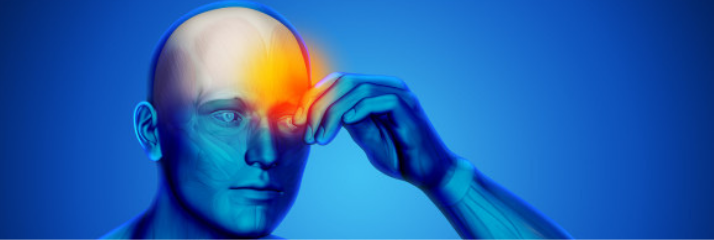Migraine headache is a rigorous pain and is often followed by a repetitive attack of constant headache. It usually affects one side of the head.
It gives sensory warning signs such as nausea, vomiting, blind spot, extreme sensitivity to light and sound, tingling in the arms and legs.
They can last from anywhere between 4 hours to 3 days, and sometimes even longer.
Symptoms of Migraine
Migraines can begin in childhood, adolescence or early adulthood. Migraines usually progress through four stages: prodrome, aura, headache, and post-drome, though you may not experience all stages.
The main symptom of a migraine is usually an intense headache on one side of the head.
The pain is usually moderate or severe throbbing sensation that gets worse during body movements and prevents you from carrying out normal activities.
In some cases, the pain can occur on both sides of your head and may affect your face or neck.
Additional Symptoms
Other symptoms commonly associated with migraine include:
- Nausea
- Vomiting
- Increased sensitivity to light and sound – which is why many people with migraine want to rest in a quiet or a dark room
Some people also occasionally experience other symptoms, including:
- Sweating
- Poor concentration,
- Feeling very hot or very cold
- Abdominal (tummy) pain
- Diarrhea
Not everyone with a migraine experience these additional symptoms and some people may experience them without having a headache.
Phases of Migraine
1. Prodrome or warning phase: You may feel several hours and one or two days before a migraine. Including Irritability, Craving for certain foods, depression, lawless yawning, etc
2. Aura: Aura may occur before or during migraine headaches. It includes disturbances like confusing thoughts, unpleasant smells, blind spots, pins, and needles in an arm or leg, etc.
3. Headache or Attack phase: This phase can four to 72 hours or several days. A person wants to remain silent and find difficult in normal activities. He or she may experience Lightheadedness and fainting.
4. Post-drome: The final phase, it may occur after a migraine attack. symptoms of this phase are extreme tiredness, dullness, confusion, drained, etc.
An attack may not always include these phases. it may vary from person to person.
Causes of Migraine
The exact cause of migraines is unknown, but they’re thought to be the result of abnormal brain activity temporarily affecting nerve signals, chemicals and blood vessels in the brain.
It’s not clear what causes this change in brain activity, but it’s possible that your genes make you more likely to experience migraines as a result of a specific trigger.
Migraine triggers
Many possible migraine triggers have been suggested, including hormonal, emotional, physical, dietary, environmental and medicinal factors.
These triggers are very individual but it may help to keep a diary to see if you can identify a consistent trigger. It can also sometimes be difficult to tell if something is really a trigger or if what you’re experiencing is an early symptom of a migraine attack.
Preventions and Treatment for Migraine
- Avoid late night sleep and to such stress
- Maintain a regular exercise program.
- Start yoga and meditation.
- Take proper food including good nutrition without skipping meals.
- Try to reduce the effect of estrogen by avoiding birth control pills
- Deep breathing, massage therapy, acupuncture.
- Drinking lots of water
How Is Migraine Diagnosed?
You can use AOGM products to get relief for your Migraine as we have the best quality medication which is absolutely free of complication, harmless and without any reactions or side effects.
OUR ADVICE for Migraine
Put a NASYAMRUT DROP in each nostril and wait for 5 minutes.
NASYAMRUT DROP
This medicine is prepared from Tulsi ( Ocimum sanctum) 3X-1.25%; Aghada (Achyranthes Aspera) 3X-1.25%. Migraine, Headache, choking of the nose are common troubles. Put a drop in each nostril and wait for 5 minutes.

